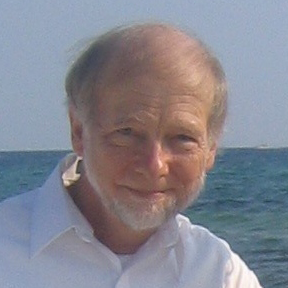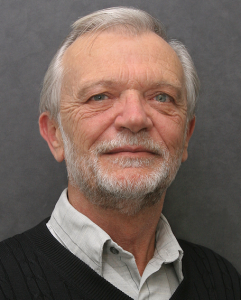The UF/IFAS Soil and Water Sciences Department is celebrating the service of three professors who have spent decades contributing to the department, its students, and the disciplines in which they pursued their research. They each have made a lasting impact among their colleagues and the students they taught and mentored. Now, Drs. Willie Harris, Peter Nkedi-Kizza, and George O’Connor are planning their futures away from campus.

Dr. Nkedi-Kizza, a professor of soil physics and hydrology, came to the department in 1979 as a post-doctoral research associate. He had just completed his PhD from the University of California-Davis.
“I had been accepted as a post-doc at the International Institute of Tropical Agriculture in Nigeria and UC-Riverside, but because of the nature of PhD research I had done at UC-Davis on solute transport through aggregated porous media, I decided to come here,” he says. “Similar research was being carried out by Drs. Jim Davidson and P. Suresh Rao.”
In 1986, Nkedi-Kizza became an assistant professor of soil physics. He notes there were four other faculty members who were also soil physicists at the time.
Dr. Willie Harris joined the SWSD as an assistant professor of soil mineralogy in 1984. He was finishing up his doctoral work at Virginia Tech, where he was working as a research associate. Harris admits he was hesitant to apply because the idea of moving to Florida was not too appealing.
“I had lived in the Limestone Valley and Blue Ridge Mountains region (of Virginia) for ten years,” he notes. “Hardly anyone wants to leave such a beautiful place. They cry and write sad songs when they have to leave.”
Eventually, Harris realized the position at UF was a good fit with his education and experience.
“My appreciation for Florida and my departmental cohorts quickly grew and homesickness for the Limestone Valley abated,” he says. “I didn’t get around to crying or writing songs.”
For Dr. George O’Connor, the appeal of working at the SWSD came at a different stage of his career. He was on sabbatical from New Mexico State University and spent time in the department. Shortly after, the department chair’s position opened up, and he jumped at the opportunity. O’Connor chaired the department from 1990-94. He was eager to return to teaching and research.
“I decided I wanted to be a university professor while I was still an undergraduate,” he recalls. “I had no idea about research, but I wanted to teach.”
O’Connor knew he had to earn a PhD, if he wanted to be a professor.
“I had some wonderful interactions in graduate school, and I understood research, but still my focus was – it’s only to get me to the point where I get to teach,” O’Connor says. “I started a typical (faculty) appointment which is 80:20, research:teaching, so you see where the heavy emphasis is!”
Research
The three have published hundreds of articles. Other scientists have cited that work thousands of times, according to data from Google Scholar. Harris focused on basic soils research initially, because he was a part of the Florida Soil Survey Program (FSSP).

“The papers produced during this period, in collaboration largely with FSSP cohorts, were some of the most significant in my eyes,” he says. “They shed some new light on fundamental aspects of weathering and genesis of Florida soils.”
He followed that work by collaborating with SWSD colleagues, and those in Environmental Engineering Sciences and Agricultural and Biological Engineering, on the chemistry and fate of such things as phosphorus, metals, and carbon in soils.
“An example of this research, that I feel contributed something substantively, was documentation of a suspected interactive effect of anions on the precipitation of calcium phosphate and efficacy of its recovery from a waste stream,” Harris says.
Similarly, O’Connor has a research focus on environmental soil chemistry. That work involves fate and transport of waste materials and their constituents.
“That’s everything from trace organics to heavy metals to salt to nutrients and the impact on the soil,” he explains.
Several areas of Nkedi-Kizza’s research are solute transport in aggregated porous media, the application of the Solvophobic theory to the interaction of strongly hydrophobic organic chemicals (SHOCs) with soils, and the comparison of Carbonatic-Marl soils with Carbonatic soils in terms of adsorbing hydrophobic organic chemicals. More recently, another study was the development of an extraction procedure of the insecticide Imidacloprid (IMD) from citrus leaf tissue and the analysis of IMD extract with HPLC-MS/MS.
“The method was important in correlating IMD concentration in leaf tissue and the Asian citrus psyllid (ACP) counts,” Nkedi-Kizza says. “The psyllids are responsible for Citrus Greening, a serious disease for the citrus industry in Florida.”
Teaching
While O’Connor is proud of his research work, he considers teaching and working with students the highlight of his career. He taught more than a dozen different courses at the undergraduate and graduate level between New Mexico State and UF. A textbook he co-authored with Hinrich Bohn and Brian McNeal, Soil Chemistry, is coming out in a fifth edition with the help of Daniel Strawn.

“We’re finishing up the fifth edition,” O’Connor says. “We started writing the first one in 1976 and it was published in 1979.”
The book also appears in Hungarian and Spanish.
“Teaching has been one of the most rewarding components of my position at UF,” Nkedi-Kizza says. “Even before being appointed in a tenure track position, I was asked by UF students and staff to advise them.”
In addition to teaching, Nkedi-Kizza served as faculty advisor to the African Student Union (ASU) at UF for nearly a decade. He also supervised students from Sub-Saharan African universities through summer courses and the Institute of International Education (IIE) programs.
“I am proud to report that two of the PhD students I recruited are now faculty members in our department – Drs. Bonczek and Kadyampakeni,” Nkedi-Kizza points out.
Harris says the interaction with students has been a very gratifying aspect of his life at UF.
“The opportunity to teach was a great privilege, but also a great responsibility that I took more seriously with time,” he says. “It was mostly joyful, but sometimes it could be humbling.”
What’s Next
For all three, their future plans are fluid, at least in the near-term. Each will be tying up loose ends in SWSD and finishing out their service on student committees.
“I want to have time to do things that I have been sort of sacrificing or not doing by virtue of my focus on work-related and other things,” O’Connor says. “Read. I’d love to travel. I want to get back into a decent exercise program.”
“I would like to complete some unfinished papers,” Harris says. “Beyond that, my wife and I plan to become more involved in community service and causes we feel strongly about. We have no plans to relocate. Gainesville has become our home.”
“I plan to continue to supervise two PhD students in our department as co-chair and one PhD and one MS student at Makerere University, Uganda, also as co-chair,” Nkedi-Kizza says. “I will write manuscripts using data from my graduate students who did not publish their research in scientific journals.”
None of them worry about the future direction of the SWSD. O’Connor cites a renewed effort to hire faculty that strengthen the Department’s core research, teaching, and Extension focus.
“I am optimistic about the future of the Department,” the former chair says. “I think the new faculty are excellent, so the potential is wonderful.”
 0
0
